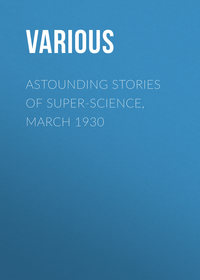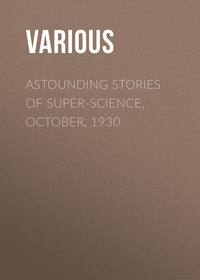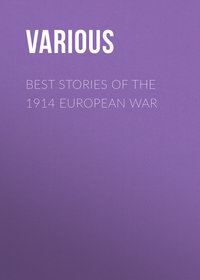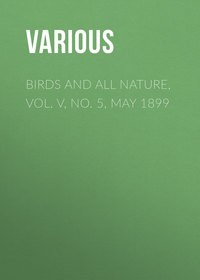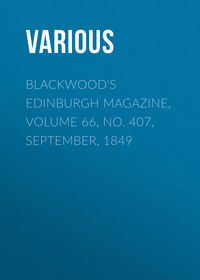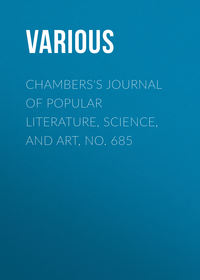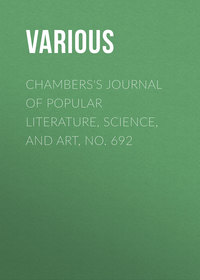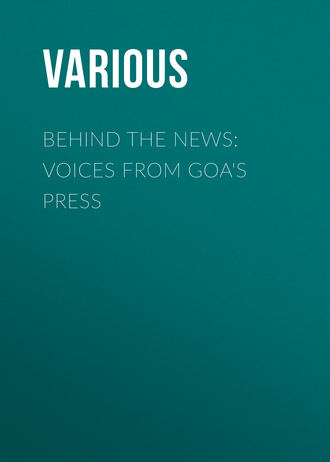 полная версия
полная версияПолная версия
Behind the News: Voices from Goa's Press
A few weeks after I was formally accepted at trainee-sub-editor a local farmer, this was before the advent of progressive farmers, or whatever they call them these days, horticulturists and what not… So, a local farmer came to the office with a very long snake-gourd. Since volunteers were hard to come by, I was ordered to pose with the vegetable. The next day my photo was published on the inside page of the Herald. I did not know whether to feel proud or embarrassed. Today, I still don't know.
After a year, I returned to Belgaum and two years later when I returned the Herald had changed. Rajan had a bigger cabin. Norman Dantas had a smaller cabin and Gustav Fernandes the manager had a cabin of intermediate size. The News Desk had morphed from two unvarnished desks to a large one with a sunmica top. Now it looked more like a cheap dining table from the Holy Spirit Church fair. It was was positioned between Rajan's and Norman's cabins and under the altar.
Rico had left and Anton had become a reporter. The others had left too. Wilfred Pereira, who was a stringer from Margao, had become chief-sub. Willy, as he was known, was a very organized man. His drawer, which was located at one end of the news-desk, was neatly kept and contained almost everything like pens, scales, soap. It was like a mini-stationery shop. I always suspected Willy also had a tin-can opener and a Swiss army knife stashed somewhere in that drawer. Willy also had a lovely handwriting.
It was during this second stint that I met Ivo Vaz from Varca. He was blessed with cat feet and always walked into the office with an old airline bag without making a sound. Ivo looked dead serious all the time, even during picnics. He once organized a picnic for Herald staffers at Varca, where he sat in one chair throughout the day. When we left, he was fast asleep. Ivo also had a strange way of editing copy which reminded me of an automobile assembly line. After editing each news story he would attach a rectangular piece of blank paper with a pin to the left-hand corner and keep it aside. After piling up several copies in this manner he would start giving each story a heading. Ivo had an antique olive green Morris Minor, which he treasured, and a daughter whom he loved. Everytime his daughter recovered from some ailment he would treat all of us to ice cream, with our peon Jose acting a facilitator in the whole process. Jose would do anything for a free cake, ice cream or anything edible.
Then there was Bone-Crusher Agnel who took pleasure in squeezing the life out of anyone who made the mistake of shaking hands with him. My hand some how survived Agnel's vice-like grip.
Another sub-editor who caught my attention was Cornelius Gomes who worked on the sports desk with Nelson Dias. Cornelius always sported a beard and mustache which covered most of his face and gave him a Ringo Starr look. Cornelius also played football for the Herald team and had this 'queer' technique of tackling rough players. When ever he encountered a player leaning on him to head the ball or digging an elbow in his ribs, he would tickle the chap's backside. This technique proved to be more effective than the ref's whistle.
By the time Herald completed its tenth year we had a formidable team with players like Tulsidas, Jason, Alaric, Jose, Domnic, Pradeep, our platemaker, and Vilas Sarang who never made it to the team. Umesh alias Umi, our sleepy paster, was a live wire in the goal. With Choppy as manager we were willing to take on anyone.
On one of our anniversaries Choppy set up a match with the Navhind Times. Two or three days prior to the match we were shocked to discover that NT would be fielding a few first division players from the Dempo team. We nearly suffered a stroke. But then Choppy always had this never-say-die attitude. In a crisis he would take two deep inhalations from an anti-asthma pump which he always carried in his pocket, and, in seconds go from Bruce Banner to The Hulk. In a day, Choppy's never-say-die attitude spread to everyone and off we marched to the Don Bosco school ground in our new uniforms for the slaughter.
Guess what? We won.
That was not all. Choppy loved ceremonies and had arranged an elaborate function with a chief guest, prizes and speeches. After the speeches the Herald team captained by Tulsidas (I think) went up and received their medals. Everyone who had adorned the Herald colours got a medal. Next was the turn of the Navhind Times team to collect their medals. Half way through this process Choppy realized that he had bought less medals. We hit the panic buttons. But then, in the Herald you have to be resourceful to survive. We quickly formed a human chain and started passing medals presented to the Herald team back to the chief guest. It was a smooth operation. Months later, when the time came for Navhind Times to celebrate its anniversary, they did not dare play a football match with us.
I also remember playing a football match on the beach during a picnic at Candolim. Our team had earned a penalty and Pamela D'Mello decided to take it. (Yes, she played football). By the way, picnic matches are scaled down versions of the world cup. The goals are tiny, the playing field is small and there's no ref. Before the penalty could be taken, a dispute broke out between us and Ashley do Rosario over how the penalty should be taken. Ashley grabbed the ball and insisted that the spot kick should be taken with the heel and with the player facing his back to the goal. I don't know where Ashley found this rule, but we were aware of Pamela's prowess as football player, and hence, objected. Those were pre-mobile phone days, so there was no way of contacting FIFA for their take on the rule. Finally after much cajoling and arm twisting, Ashley relented and allowed Pamela to take the kick. The ball was placed five feet from the goal which was one-and-half foot wide. Tulsidas, our captain, who was desperate for a goal gave Pamela a thorough briefing on how to take the kick. Next he drew a line in the sand starting from the ball to the center of the goal line to make it easier for Pamela. Ashley did not object. We all stood back and waited. Pamela positioned herself behind the ball, lifted her right foot and kicked with all her might. The ball missed the goal by three feet. That was how Pamela missed her chance to enter the Herald football hall of fame. She went on to be a very good reporter.
This was also the picnic when Ashley drove from Candolim to Betim in his Fiat without releasing the handbrakes.
Somewhere during the eight years I lived and worked in the Herald, a fellow villager named Lirio Vasconsales found employ as a sub-editor. This wiry chap had a face full of hair and was a die hard Navhind Times fan. He used to fold the NT and stuff it into his trouser pocket, to be retrived for leisure reading on the last bus to Margao. This habit earned him a sobriquet – pocket Navhind Times. Lirio also possessed a matter-of-fact sense of humour. One day Lirio was feverishly editing copy with a ball pen refill even though he had an empty ball pen in his pocket. Sports editor Nelson Dias, who happened to pass by, asked Lirio: "Arre baba, why don't you put the refill in the pen and use it?" Lirio looked up at him through his glasses and said: "No time". This was the one and only time I saw Nelson hit for a six.
In those days before the lazer printer was perfected by HP the A4 sized `butter` paper used to get `jammed` inside the machine very often. During one such occasion Lirio who had been observing the machine for over half-an-hour in the composing department turned to me and said: "We insert butter paper in the machine, so how do we get paper jam?"
My first encounter with Rajan Narayan was not awe-inspiring. Rajan was never a dresser and, on the few occasions when he managed to get into a long sleeved shirt and ironed trousers, he looked quite smart. The first time I saw him for one of the anniversaries when he came with a slightly over-sized navy blue coat. The next occasion was when he returned from Dubai on the first Air-India direct flight from the Gulf. His attire never bothered him or any of the staff.
Rajan had two indulgencies – smoking and chewing `Halls' sweets. And the smoking nearly burnt him out one day. I was in the office that day when a couple arrived to see Rajan. As usual he lit a cigarette and was puffing away when the couple noticed smoke under the table. It didn't take long for Rajan to realize that his trouser pocket was smouldering. He thrust his hand into the pocket to put out the fire and in the process burnt his fingers. After a little slapping here and there the fire was put out. I was quickly summoned and told to buy a tube of Burnol. Rajan never believed in moderation. He squeezed half the tube on his fingers and continued conversation with the couple with the yellow paste all over his hands. I don't know how his pocket caught fire, but I think Rajan absent mindedly shoved the match in his pocket instead of the ashtray.
There were a lot of other interesting incidents that happened in the Herald, some nice, some not so nice. Like how we played mandicot all night in the composing room or how we celebrated on Independence eve with a bottle of whiskey and nearly got caught or the formation of the Union, or the time when the electrical system short circuited and Pamela, Alaric and Paul filed stories in candle light, or Rico's hoi-te.
Perhaps some other time? Perhaps, for the twenty-fifth anniversary e-book.
Chapter 12: The proof of it all…
Tony MartinTony Martin, the better-known pen-name of Anthony Barretto, worked his way through Goa's English-language newspapers, before shifting to education. He has gone into self-publishing, and, in his own modest and low-profile manner, has managed to put out books with a print-run of 5000 copies (amazing by Goa's standards). Currently, he is working on a website on Canacona.
Just an out-of-school teenager that I was, life then posed a 'Catch 22' situation when one first landed in Panjim. Without any experience, it was difficult to get work. Yet, at the same time, it was difficult to get experience because I couldn't get any work.
So one fine day armed with a recommendation from the late music maestro-priest Fr Lourdinho Barreto, who hailed from my village of Galgibaga in the southern extreme of Goa, to Fr Freddy for the post of proof reader I arrived at the Gulab office. This got an I'll-let-you-know from the editor.
Well at least I knew what job I was looking for.
Then, with a fantastic helping of luck I got a job with the Herald – oops actually it was with Norlic India, the firm shown as the employer of those doing the proof-reading of the Herald, in those days.
The job was as a proof reader, and the date was August 12, 1985.
To us, whether it was Norlic India or Herald did not then matter, I was getting my bread, so there was no point complaining about missing the cake.
But along with my bread, I also got a taste and a first-hand glimpse of what I had only heard of earlier – exploitation. Obviously the Norlic India tag was meant to deny us the applicable scales for proof-readers. We were almost like daily wage factory workers. Accept it or leave it. With pressing financial constraints, and at that time there wasn't even a functional union in the Herald (it came sometime later, and have worked in fits and starts) the option was clear: shut up and do your work or speak up and get kicked out.
All said just-enough-to-survive Rs 400 a month was still a luxury.
So I got myself testing the waters in the novitiate of journalism. For a tender 'naal' (coconut) like myself the sub-editors of the time – Anthony, Rico, Godwin Figueira and sports editor Nelson, to name a few – were exceptionally good. If I had peanuts for salary, I had gems for seniors.
For most people proofreading is basically checking spellings and omissions by the typesetter. It was not much different here. On the few occasions we, the humble proof-readers, particularly Jack, ventured to show our mastery in punctuation and grammar, the concerned sub-editor would get furious, of course in a playful way. Often we would end up exposing our ignorance to the world.
Ignorant or well-informed, those two years in the Herald were years of youthful exuberance and bliss.
And there was this noble soul Caetano. Well I call him a noble soul because even as the foreman of the composing section, he never gave me an opportunity to see him angry although we proof readers (which, of course, includes me) used to give him a chance to be angry almost every day.
One day when 'penis' became 'mightier than the sword', he laughed at it together with the subs, and then, after they had left, politely warned us to be careful. He had no special training in people-management; he had surely not attended any hi-fi seminars now conducted by self-proclaimed management gurus. Yet, if there was one thing he knew other than typing at an incredible speed, it was to keep his juniors motivated. We owed our productivity and effectiveness to him. He would challenge the Subs to a rupee for a mistake in a report or an article. On that count we didn't let him down, at least not often, even considering that overlooking errors in a straight read-through – without the luxury of checking print-outs, but doing the proofreading on the flickering screen itself – was a distinct possibility.
Ironically, on the few occasions, the editor, Rajan Narayan – he was not yet the super-man of the Herald then; he acquired almost that status during and after the language agitation – entered the composing room, we were just logs of dead wood for him. Not a side glance even to acknowledge our greeting. My view: perhaps all these years Mr Narayan was soaring too high on the pedestal the management had seated him on, after granting him a free hand. And as is the rule of nature, every thing that goes up comes down. And he came down with quite a bang.
But that was just a stray cloud in the silver lining the Herald offered. That indifference apart, our Herald innings is something to look back and laugh about. I can still sense the taste of the first sip of urak at an after-work session. Not long later, Remy and I crashing into a cow with my rickety cycle on our way to the Don Bosco Hostel. Time: around 3 a.m.
Another party we had in the office was a chicken party. Nice dry fried chicken. Courtesy Jack. Everybody had and there was still more to go around, much like in the Biblical parable of loaves-and-fishes. But nobody except Jack knew, until the next day, from where the chicken came. The next day a notorious looking man walked into the Herald office. To make bad matters worse he happened to meet the 'patrao', the publisher and then patriarch A. C. Fernandes. They talked a while and he left. The next moment the old man came charging and thundered, "Kal kombeo konnem adleo re?" (Who brought in the chicken yesterday?) "Aayem Patrao, mhaka rostear podlo mevloleo," (I, boss. I found it fallen on the road) Jack confessed not unlike a frightened rabbit. "Faleamson kamank enaka," (You're fired). And Patrao left. Of course all those who had enjoyed the chicken the previous day came to Jack's rescue.
In the good old days, the pace was leisurely, stresses fewer and everything was rosy. But the pay packet was not growing significantly heavier even after two years. I was stuck at Rs 500. We were free to ask the then Manager Gustavo Fernandes for anything except a raise. Asking for a raise was invariably met with a simply question, 'Do you want to continue?'
There was no choice. Choice came knocking with the arrival of Gomantak Times. And some of the more enterprising journos left their training ground and joined GT. But, to this day, Herald remains an enriching and fond experience.
Chapter 13: Birth pangs at Sant Inez
Elston SoaresElston Soares, a veteran of the desk, has worked at the Herald, Newslink and Gomantak Times. Since moving out of Goa, he has worked in publications in the Gulf and Singapore.
February 15, 1987 marked a watershed in the history of English-language journalism in Goa. That date marked the launch of Goa's fifth English-language daily to be launched in the union territory-turned-state.
Fifth, that is, if one includes the now defunct West Coast Times and Newslink, an English-language newspaper launched by the Tarun Bharat Group, and targeted at Goa, though like the Tarun Bharat in Marathi earlier, it too was printed from the neighbouring city of Belgaum.
This writer spent two months with Newslink in late 1986 in Belgaum, together with Haseeb Shakoor and Derek Almeida, bringing out the newspaper in very trying and primitive conditions.
Strangely, the Tarun Bharat group then thought that they could do another Tarun Bharat with Newslink, that is, to produce a newspaper for the Goa market from Belgaum. But with one significant difference.
We did not have the wide correspondent network of Tarun Bharat. We were, instead, expected to translate the stories from Marathi – something we did rather more successfully in Gomantak Times a few years later.
But then, at Belgaum, this was a task easier said than done. And as anyone who has tried translating stories from Goa's Marathi press will testify, most stories contain enormous amount of comment and a large number of them are un-sourced.
Our plight could therefore be well imagined. Things I guess have become somewhat better in the last few years; but then it was a nightmare. Trying to fill up six broad-sheet pages with material translated from Tarun Bharat was way too optimistic a goal, to put it mildly. So at best you managed a couple of pages. The rest of the paper was trusty old teleprinter copy, courtesy UNI (United News of India) and PTI (Press Trust of India).
And as for our own reporting resources, there was Lionel Messias who slaved all alone in the Panaji office. This couldn't last. So in early December 1986, when the Gomantak Group advertised for staff, I jumped at the opportunity and applied. Besides being a good opportunity to return home from Belgaum – anyway one used to travel home every week – the adventure of being there as a newspaper was being born was too good to miss.
Not that I was totally unfamiliar with the birth pangs of newspapers – having joined the Herald as a trainee when it was a few months old and Newslink when it was in a similar position. But, birth pangs or whatever, there's nothing like competition to add a little excitement. It shakes up established players, and all the poaching for staff only pushes up salaries and gives hitherto ignored journalists their day in the sun.
I too was offered more money – more than double my last salary drawn in the Herald – which I had quit a few months earlier in less than happy circumstances. Meanwhile, just as Gomantak Times was about to be launched, Rajan Narayan in his inimitable style launched a broadside against the to-be-launched newspaper. For days, he wrote about how the Maharashtrawadis were planning take over Goa's English-language media. Never mind that most of the to-be-launched paper's staff were old Herald hands.
However, GT – as the paper was later referred to – seemed on to making great progress as we neared launch date. For the first time in the history of Goa's English-language media, we had newspaper designers working on what the paper would look like. A two-man team from what was then Bombay was paid a princely sum of Rs 25,000 to come up with the new design.
But that was where the good news stopped. The company which had sold the Chowgules the desk-top publishing equipment for the new newspaper had amazingly been able to convince the management that there was no need for paste-up artists. So there we were, trying to put together a newspaper without artists or computer operators or journalists who could do screen-based page layout.
There were no dummy runs; in fact, on the night before the first edition, I was forced to call one Herald's former paste-up artists to come in and help produce the paper. Today, all this may sound strange – given the technological innovations of the last decade – but then it was crazy, particularly given that the Chowgules had a fully functioning newspaper Gomantak and should have known better.
Then to the issue of staff recruitment, and and one of my pet peeves.
Goan newspaper managements have always hired journalists from outside the state – at exorbitant salaries – believing them to be better than local talent. And so was the case with GT, where my then chief-sub colleague, a sub from the Times of India, was paid twice as much as I was. But just because they are imported, foreign talent isn't always good or suitable for the job at hand. This Bombay veteran was such a miserable creature that on launch night, with editor Mohan Rao shouting his head off, one was forced take charge and ensure that we got the paper to the press.
But no mention of this paper's launch can be complete without a mention of the role Gomantak editor Narayan Athawale played. While generally supportive of the idea of the newspaper in the early days, including recommending the hiring of staff whose knowledge of the language was less than adequate, he almost knocked the paper off its feet before it was launched.
For this the late Mr Rao was to blame; but it was an innocent mistake. A few days before the launch, Mr Rao asked Mr Athawale to write a piece for the new newspaper – it remains the only one he ever did.
And with good reason.
In it, he proceeded to say that the new newspaper would convey the views of the Marathi Gomantak in English. It was a ridiculous claim; but something that the new newspaper took years to live down. This proved to be a real gift to the paper's rivals, which they exploited to good effect.
The early days with GT were fun, because most people didn't give us much of a chance. Our staff resources too were meagre. There was Pramod Khandeparker, who was the Assistant Editor but was more of a chief reporter; and a retired English professor M.N. Pal as news editor – who spent a few months with us – and G.K. Mohan Nair, the ToI sub.
Ex-Herald colleagues included Francis Ribeiro. And among the trainees was my good friend Vidya Heble. But most of the staff were raw and we stumbled along in those early days. The first year passed with GT barely making a dent. I believe that the paper's circulation barely exceeded a few hundred copies. And as the second anniversary approached, Mr Mohan Rao was preparing to say his goodbye. He original brief was to set up the paper and leave after two years.
This set the stage for Ashwin Tombat to take charge of the paper. And immediately we began to see a dramatic change in the paper's fortunes. Of course, we were helped along by the Narvekar molestation scandal. But to be fair, it's not the issue that matters, but how you handle it. If we did manage to raise our circulation it was because of our reporting. Some in media, did take exception to the fact that we named the girl.
But I feel it was needed then, specially if you have are up against a powerful political figure. For those who still doubt this view, I can only point to the way the Miramar sex scandal died down without the guilty being brought to book. However, one is not suggesting that the victim in sex abuse cases should be named. The only reason I have raised this issue is to explain why the girl was named.
Sorry for digressing; but another turning point in the history of paper came in 1993 when we were faced with a contempt notice from the Supreme Court. Sadly, this proved to me that whatever a management tells you, if you get into trouble you face it alone. In the case in question, we were hauled up for what was taken to be a suggestion, in a cartoon, that a Supreme Court judge was being bribed to adjourn a hearing in a case related to the disqualification of then chief minister Ravi Naik.
How I got involved in the matter – even though it was my day off – is another matter. But the real icing on the cake was that what the court claimed we had suggested in the cartoon apparently was the truth. Unknown to us then, a colleague in our sister newspaper had apparently tried to bribe a judge. But the deal had fallen through because the judge wanted more money than the politician was willing to pay. The story came out when the journalist apparently did not return all the money that he was given by politician and claimed he had incurred "expenses".
Ravi Naik ultimately resigned, ironically after himself losing an appeal against his disqualification in the Supreme Court; and I was cleared of contempt charges.




